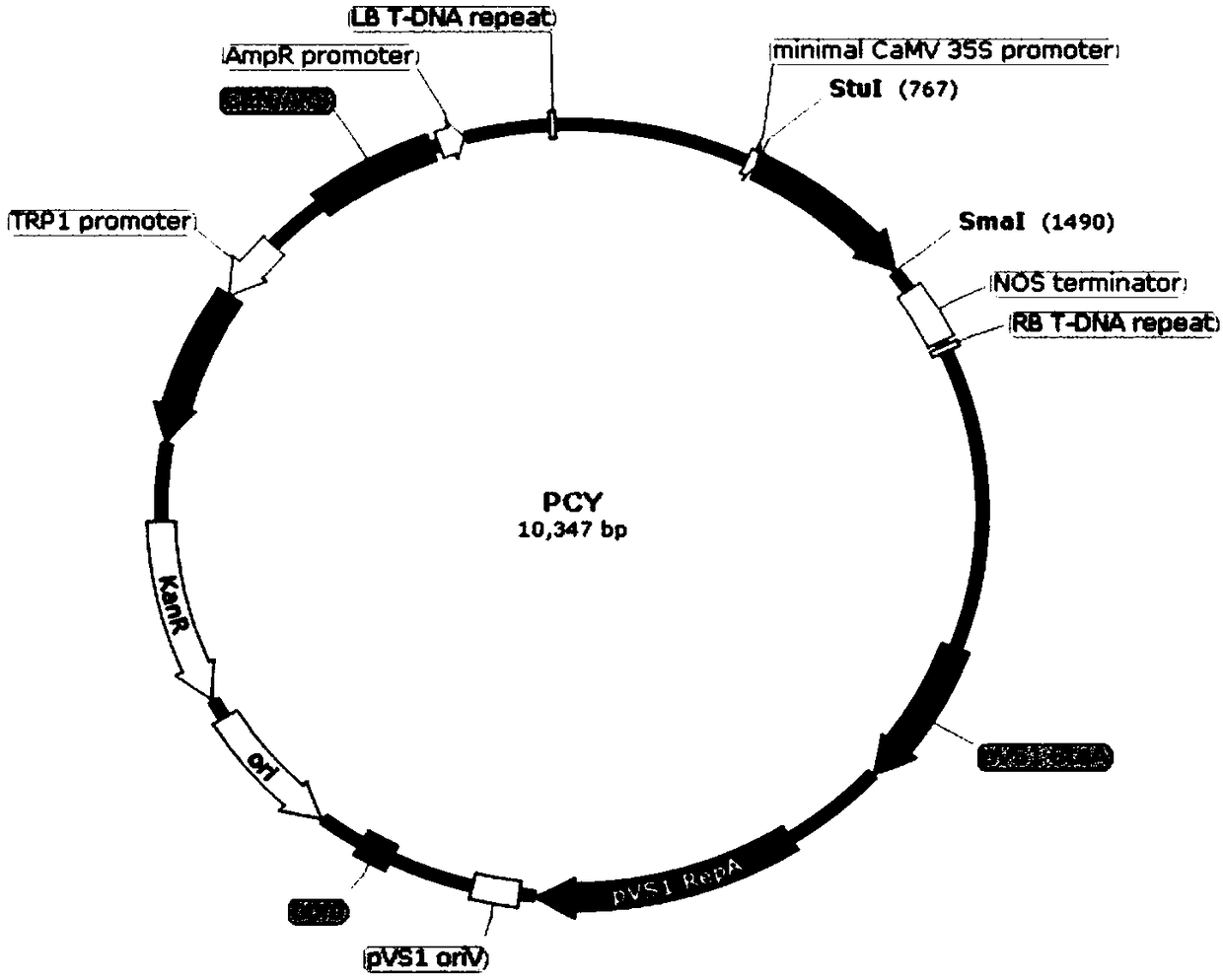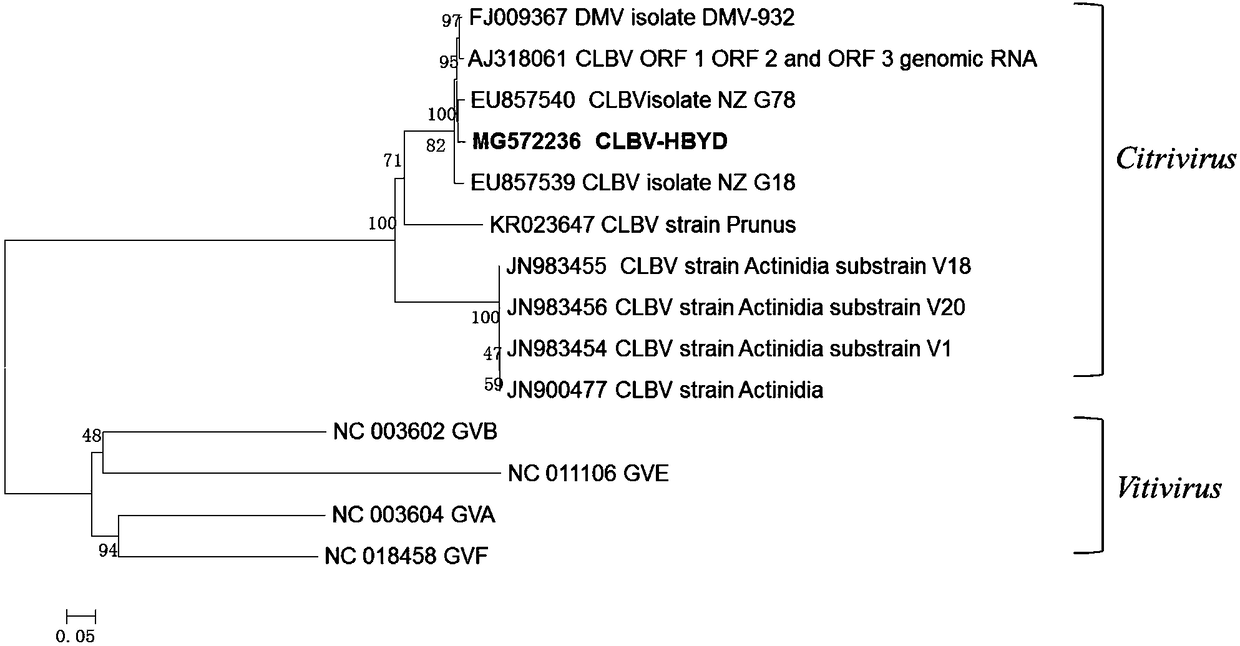Ternary shuttle vector and method for establishing CLBV (Citrus Leaf Blotch Virus) infectious cloning with same
A technology of shuttle vectors and vectors, applied in the field of molecular biology, can solve the problems of difficulty in obtaining CLBV invasive clones, time-consuming and labor-intensive success rate, etc., to improve the acquisition rate of invasive clones, overcome toxicity or instability, and speed fast effect
- Summary
- Abstract
- Description
- Claims
- Application Information
AI Technical Summary
Problems solved by technology
Method used
Image
Examples
Embodiment 1
[0033] Example 1 Construction of the ternary shuttle vector pCY
[0034] Firstly, the binary vector plasmid DK1317-2 was constructed: it was obtained by transforming plasmids PCMBIA1301 and pXT1. PCMBIA1301 was purchased from the market, and the pXT1 vector was donated by Professor Tao Xiaorong of Nanjing Agricultural University. Using the pXT1 vector as a template, primers TL1310F / TL1310R were used to amplify the fragment containing the pXT1 gene expression module (LB-2x35S-MCS-HDVRZ-NOS-RB). The pCAMBIA1301 plasmid was digested with Pvul. The amplified and digested products containing the expected fragments were then purified and fusion recombined using a gel extraction kit. The resulting fusion plasmid was digested with VspI, and the large fragments were reconnected to construct pCAMBI-2x35S-MCS-HDVRZ-NOS, namely DK1317-2.
[0035] The binary vector plasmid DK1317-2 was single-digested with restriction endonuclease Sac II to obtain a linearized vector. Enzyme digestion r...
Embodiment 2
[0038] Embodiment 2 constructs the invasive clone of CLBV
[0039] 1. Extraction of total RNA from susceptible leaves and segmental amplification of CLBV
[0040] Total RNA was extracted from susceptible leaves according to the instructions of Trizol reagent, and the integrity of RNA was detected by agarose gel electrophoresis. Using the extracted total RNA as a template, use PrimeScript TM II 1st Strand cDNA Synthesis Kit, synthesizes the first strand of cDNA. Using the cDNA as a template, two pairs of specific primers pCY-CLBV1F, CLBV1R and CLBV2F, pCY-CLBV2R were used for PCR amplification respectively, and two specific fragments CLBV1 and CLBV2 covering the entire length of the CLBV genome were obtained, with sizes of 4500bp and 4247bp respectively . The PCR reaction system is 25 μL, including: 8.5 μL of double distilled water, 12.5 μL of PrimerSTAR Max Premix (2×), 1 μL of specific upstream and downstream primers, and 1 μL of template. Reaction conditions: 98°C for 1m...
Embodiment 3
[0058] Example 3 Shuttle vector pCY is used for PVX invasive clone construction
[0059] Referring to the method of Example 2, the shuttle vector pCY of the present invention was used for PVX (Potato Virus X) invasive clone construction, the amplification of PVX full-length cDNA used primers pCY-PVXF, pCY-PVXR, and the yeast colony PCR detection used primers PVX-F, PVX-R. Transform the positive pCY-PVX plasmid into Agrobacterium C58C1 and infiltrate Nicotiana benthamiana through Agrobacterium injection. After 10 days of inoculation, the observation results show that the symptoms of tobacco injected with pCY-PVX are exactly the same as those of the positive control, and the symptoms of the tobacco injected with pCY-PVX are obviously the same as those of the negative control. comparison (such as Figure 5 shown). This shows that PVX has been highly expressed, and the yeast recombinant cloning system based on the three-way shuttle vector pCY has been successfully constructed, w...
PUM
 Login to View More
Login to View More Abstract
Description
Claims
Application Information
 Login to View More
Login to View More - R&D
- Intellectual Property
- Life Sciences
- Materials
- Tech Scout
- Unparalleled Data Quality
- Higher Quality Content
- 60% Fewer Hallucinations
Browse by: Latest US Patents, China's latest patents, Technical Efficacy Thesaurus, Application Domain, Technology Topic, Popular Technical Reports.
© 2025 PatSnap. All rights reserved.Legal|Privacy policy|Modern Slavery Act Transparency Statement|Sitemap|About US| Contact US: help@patsnap.com



